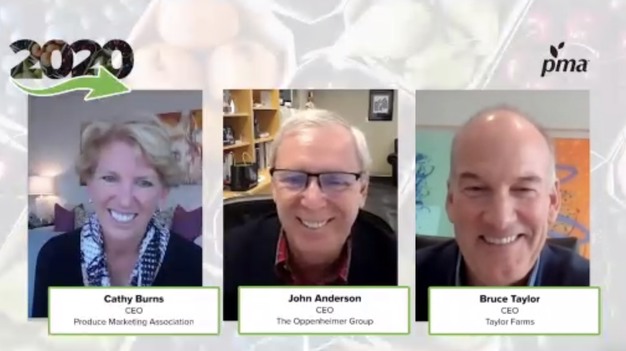This week’s PMA virtual town hall marked the 37th and last installation of 2020 and featured John Anderson, Chairman and CEO of the Oppenheimer Group and Bruce Taylor, Chairman and CEO of Taylor Farms who, led by PMA CEO Cathy Burns, looked back on 2020 and discussed what expectations they have for both the short-term and long-term future.

Looking back on 2020
There has been much discussion on how 2020 has been for a variety of companies and sectors within the produce industry. For Anderson and Taylor, the overall takeaways of this year were the importance of diversification, adaptation, and resilience. “Everything happened so quickly,” says Anderson. “The rapid changes in sales volumes – with foodservice going down and retail going up – highlighted our industry’s impressive ability to adapt.” Taylor agrees, adding: “It was very heartwarming to see how resilient our team and the entire industry really are. We have 16 operating companies and each one responded to different challenges with the same goal of taking care of our people and our customers.”
The events of 2020 also highlighted some weaknesses in the supply chain and industry. “One thing that was a real eyeopener to me was seeing the level of risk we, as producers, bear,” says Taylor. “When foodservice shut down, we had $70 million worth of vegetables in the ground with no home. It really highlighted the importance of diversification and balance in the business,” he shares. For Anderson, the importance of automation became clear during the pandemic. “Labor issues were highlighted everywhere. We operate all over the world, from South America to Asia and the labor issue was really ubiquitous across all of these regions. Labor issues will continue to be a challenge and automation will be the way to mitigate it,” he says.
Future of the produce industry
With so many changes happening very quickly this past year, everyone is wondering what the coming years might look like for the produce industry. “I think it will continue to be a rollercoaster,” says Anderson. “As some regions are in lockdown again at the moment, consumption patterns have changed again. As the vaccines are distributed and the pandemic starts winding down, these patterns will change again. I think we will see a resurging of foodservice in the spring, but it will level off after that initial surge,” he adds.
“The vegetables that are grown for retail are different than the ones used by foodservice,” Taylor says. “So, it will be important to keep a close eye on the foodservice industry to make sure that the products they are looking for are planted at the right time and ready to go when they are. The first quarter will definitely not be the right time yet, but we think maybe around the end of March or the start of April will be when it starts to slowly come back,” he explains.
The recovery of the global economy will also play an important role in the coming years. “In the upcoming year, I foresee a lot of global disruption. There will be shifting currency values around the world and this will affect both where produce is grown and where it is exported to,” says Anderson. Taylor also expresses concern for global inflation: “The overall cost of production has increased – adapting to the pandemic, inputting new protocols, and more, have all contributed to that – and the customers and consumers aren’t helping to absorb those costs. So that will either drive some people out of business or reduce the quality of the products that are produced. If inflation and reduced purchasing power are added to that, it could be a real challenge. So, the industry needs to come together and allocate these increases in costs fairly.”
Innovation to help drive consumption
Being stuck at home has made consumers more openminded and excited to try new products, which presents great opportunities for the industry. “I’ve been pleasantly surprised at the embracing of new products that we’ve seen,” says Taylor. “That has helped to drive consumption, and we’ve been able to continue to introduce new products at the same cadence as we usually do,” he shares. Oppy has also introduced new products this year, says Anderson, “and the consumer has absorbed them quickly,” he says.
Innovation in business also continues to be important. “In the future, I think data mining will prove to be very important. Using data to our advantage can become a real cost-saver. Closely monitoring soil health, for example, would allow us to reduce the amount of fertilizer used. Breeding technology will also grow in importance and will allow us to develop better-tasting products, enhance food safety and the marketability of our products,” says Taylor. Anderson adds: “We’ve been looking a lot into shelf-life extension opportunities, which will allow our products to travel farther and arrive in the best condition possible, so that the consumer can have better eating experiences.”
“The produce industry will remain a vibrant industry for us to continue to improve on,” Anderson adds. “It will be challenging, but there will also be a lot of opportunities in the future. There will be ups and downs in the next few years, as we work our way out of the pandemic, but I see a bright future for our industry,” he concludes.
The next PMA virtual town hall will take place on Wednesday, January 6th. This upcoming town hall will feature a conversation between Food Safety Attorney Bill Marler and PMA’s Chief Science Officer Max Teplitski on how food safety concerns of the past can be addressed in the new year.
